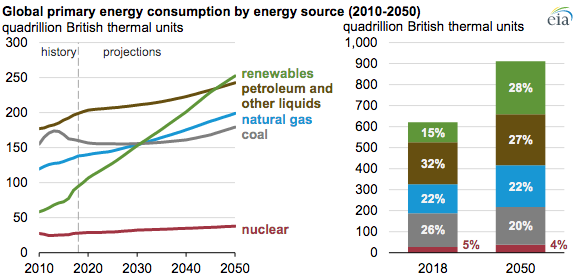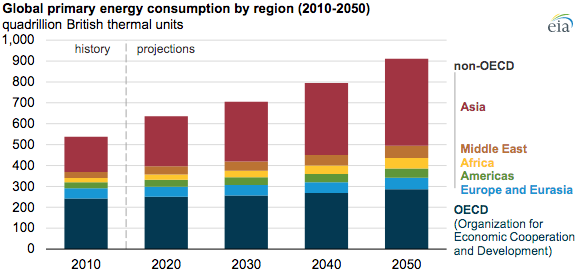The Energy Information Administration (EIA) recently released its International Energy Outlook 2019, forecasting that global energy consumption is expected to increase almost 50 percent by 2050. Consumption is expected to skyrocket in India and China because of the energy requirements of energy-intensive manufacturing. Due to population and economic growth, energy-related carbon dioxide emissions are expected to increase at an average rate of 0.6 percent per annum. Lifting people out of poverty and improving lives requires vast amounts of energy, and the EIA suggests that is exactly what will happen.
Renewable energy (including wind, solar, and hydropower) is projected to be the world’s fastest-growing form of energy over the next several decades (growing at a rate of over 3.1 percent per year). Despite that, fossil fuels are expected to meet most of the world’s energy demand. Liquid fuels are expected to remain the primary energy source for transportation, but electric-powered transport, particularly for personal electric vehicles, is expected to grow in popularity. Electricity generation is expected to increase by 79 percent by 2050 driven partly by demand from the transportation sector for vehicles and rail and partly by its use in the residential and commercial sectors due to growing income, growing population, and increased access to electricity in non-OECD regions.
Global consumption of liquid fuels is projected to increase over 20 percent between 2018 and 2050, with total consumption reaching over 240 quadrillion Btu in 2050. Global oil production is expected to increase by 30 percent from 2018 levels to 127 million barrels per day in 2050, with non-OPEC producers accounting for about 55 percent of the output.
Consumption of petroleum and other liquids is expected to grow at 0.6 percent per year, coal at 0.4 percent, and natural gas at 1.1 percent per year between 2018 and 2050. Despite higher growth rates for each of the fossil fuels, the coal share and the liquids share of primary energy consumption declines by 2050.

Coal
Despite its lower share in 2050, global coal consumption is projected to increase in the latter decade due to its use in industrial processes, including the production of cement and steel. Coal use is projected to decline until the 2030s as it is replaced with natural gas and renewables in electricity generation mainly as a result of policy initiatives. In the 2040s, coal use increases as a result of increased industrial usage and increasing use in electric power generation in non-OECD Asia, excluding China. India is expected to become the largest importer of coal in 2050.
Natural Gas
Global natural gas consumption is projected to increase over 40 percent between 2018 and 2050, with total consumption reaching nearly 200 quadrillion Btu by 2050. In addition to the natural gas used in electricity generation, natural gas consumption increases in the industrial sector. Chemical and primary metals manufacturing, as well as oil and natural gas extraction, account for most of the growing industrial demand. U.S. natural gas production is projected to increase by almost 50 percent to 43 trillion cubic feet by 2050, primarily from expanded production in Texas and Appalachia.
Global Demand
Demand in OECD countries remains relatively stable during the projection period, but non-OECD demand increases by about 45 percent, primarily in Asia.

Utility-Scale Renewable Energy
Generation from non-hydropower renewables is projected to increase at an average of 5.7 percent per year from 2018 to 2050. By 2050, China, India, OECD Europe, and the United States are responsible for more than 80 percent of the world’s non-hydropower renewable generation. Electricity generation from wind and solar resources is projected to increase the most between 2018 and 2050, reaching 6.7 trillion and 8.3 trillion kilowatt hours, respectively, as these technologies become more cost competitive and because they are supported by government policies in many countries, including subsidies and mandates in the United States. By 2050, wind and solar account for over 70 percent of total renewables generation. In OECD countries, where more policy initiatives affect electric generation, electricity demand growth is expected to be met primarily with renewable energy, which is also expected to displace some existing generation.
Conclusion
In EIA’s international forecast, fossil fuels are expected to supply almost 70 percent of the world’s primary energy demand in 2050, led by petroleum and natural gas. Coal is still expected to supply a 20 percent share due mainly to growth in Asia’s electricity generation and industrial sectors. Renewable energy (primarily wind and solar) are the fastest growing source of fuel; they are expected to supply almost 28 percent of global primary consumption in 2050—a greater share than any other fuel.



